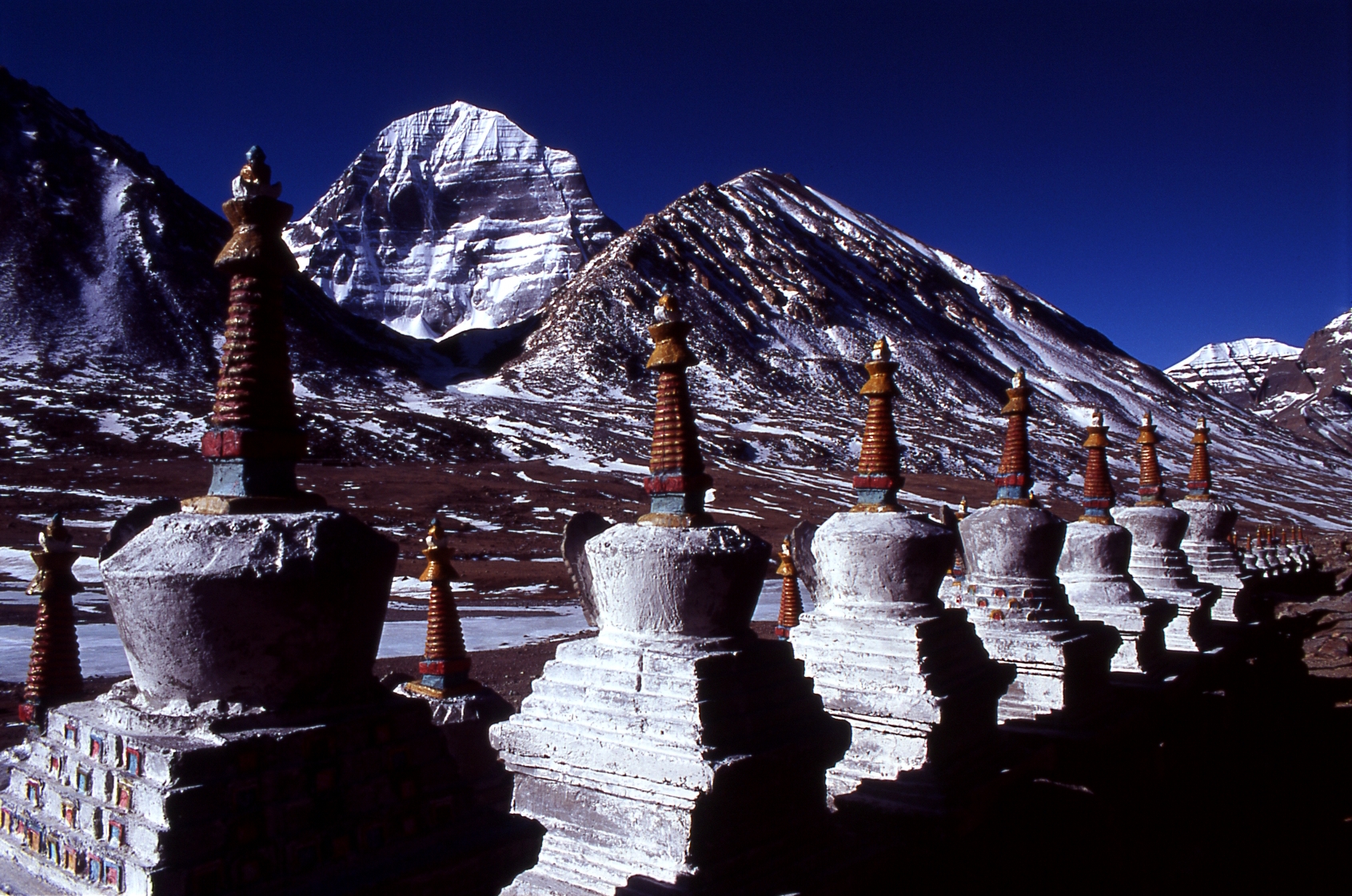Mount Kailash is located 20 miles from Mansarovar; it appears like a giant Shivalingam placed in a 16 petaled lotus. Pilgrims first reach Darchin, and then start their 32 mile pradakshina or circumambulation around the sacred mountain. From Darchin, they proceed to Landifu, then Derfu, and then in a north east direction to Gowrikund 19000 feet above sea level.
The towering 22028 ft high peak Mt. Kailash in the Himalayas, 25 miles north of the Mansarovar lake is hailed as the abode of Shiva. It is an arduous trek to Kailash through the snow clad Himalayas and is attempted only by a few. The Tibetians refer to Kailash as Kangrimpoche (Jewel of Snow). Kailash is also referred to as Hemakootam.
How to reach Kailasam:
Pilgrims go to Kailash via the Lipu Lekh pass. They first go to Tonakpur, then through Pithorgarh, Askot and Dharchula and Garbiang the last town in Indian territory. The Lipu Lekh pass is 16750 feet above sea level, and is at the Tibet frontier. Pilgrims then reach Taklakot, a Budhist center. Manasoravar is 34 miles away from here. 12 miles from Taklakot in Bhutan, is Kocharnath.
Kailasam is a holy place for Lord Shiva . It is located in Mount Kailash, Tirukkayilaayam. This holy Shrine is one among 275 Shiva Sthalam and it is one among Vada Nadu Shiva Sthalams.
According to Hinduism, Lord Shiva, the destroyer of ignorance and illusion, resides at the summit of a legendary mountain namedKailāśa, where he sits in a state of perpetual meditation along with his wife Pārvatī. He is at once the Lord of Yoga and therefore the ultimate renunciate ascetic, yet he is also the divine master of Tantra.
Mt. Kailash is regarded by Hindus as an embodiment of Shiva and Parvati. The Buddhists refer to the sacred mountain as Kangri Karchchak; they regard the presiding deity of Mt. Kailash as Deity with three eyes, holding the damaru and the trishul; his consort is referred to as Dorje Fangmo. The Jains regard Mt. Kailash as the Ashtapada mountain where the first Tirtankara Adinath (Rishabhadeva) attained nirvana.
Tirunavukkarasar on his way to Kailasam is said to have been transported by divine intervention to Tiruvaiyaru - Dakshina Kailasam. Karaikkal Ammaiyar is said to have trekked to Kailasam and returned to Tiruvalangadu.
Sundaramoorthy Nayanar is said to have travelled to Kailasam on a white elephant, while his contemporary Cheraman Perumal Nayanar of Tiruvanjaikkalam composed Tirukkayilaya Gnana Ula at Mt. Kailash. Sambandar sang praises of Kailasam from Sree Kalahasti. Kailash is the fifth of the Tevara Stalams hailed by the Tamil hymns of the Nayanmars.
Every year, thousands make a pilgrimage to Kailash, following a tradition going back thousands of years. Pilgrims of several religions believe that circumambulating Mount Kailash on foot is a holy ritual that will bring good fortune.
Do:
- Do pray your Ishta Devata before pilgrimage to Temple.
- Do contact Temple Devasthanam information centre for enquiry, temple information and for Pooja details etc.
- Do reserve your travel and accommodation at Temple well in advance.
- Do bath and wear clean clothes before you enter the temple.
- Do concentrate on God and Goddess inside the temple.
- Do maintain silence and recite your Istamantram to yourself inside the temple.
- Do observe ancient custom and traditions while in Temple.
- Do respect religious sentiments at Temple.
- Do deposit your offerings in the hundi only.
Don't s:
- Do not come to Temple for any purpose other than worshipping of God and Goddess.
- Do not smoke at Temple.
- Do not consume alcoholic drinks at Temple.
- Do not eat non-vegetarian food in the Kshetram.
- Do not approach mediators for quick Darshanam. It may cause inconvenient to others.
- Do not carry any weapon inside the temple.
- Do not wear any head guards like helmets, caps, turbans and hats inside the temple premises.
- Do not perform Sastanga Pranama inside the Sanctum Sanctorum.
- Do not take much time while performing Sparsa Darshanam to God in Garbhagriha.
- Do not buy spurious prasadams from street vendors.
- Do not encourage beggars at Temple.
- Do not spit or create nuisance in the premises of the temple.
